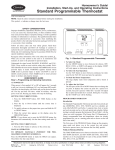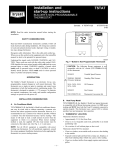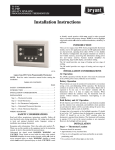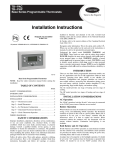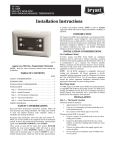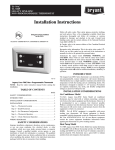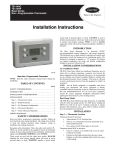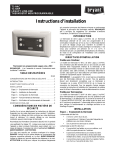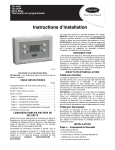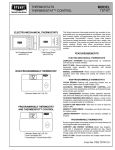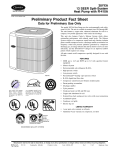Download Bryant II TSTAT-0-16 Operating instructions
Transcript
Homeowner’s Guide/ Installation Instructions TSTAT STANDARD PROGRAMMABLE THERMOSTAT Cancels: II TSTAT-0-23 II TSTAT-0-28 7-99 Programming and Operating Instructions AT POWER UP When power is first applied, AC or HP will appear for 5 seconds to tell you it is an air conditioner (AC) or a heat pump (HP) model. After this, the time display will flash to tell you the power has been off. The day and time will show, within 10 minutes, when the power went off. Pressing any button will stop the flashing. A. Setting the current time: 1. Press the TIME/TEMP button. SET TIME flashes on the display. 2. Press the Up or Down button until the correct time is displayed. A99069 Fig. 1—Standard Programmable Thermostat heat set point, and cool set point can be set for each period and schedule. Before starting to actually program the thermostat, fill out Table 1 with the values you wish to program. (The Energy Star, US Department of Energy recommended time and temperature values are already programmed for you as a starting point and are shown on the left side of the table.) The first press of the PROGRAM button brings up the programming mode and places you at the current day and period. Successive presses move you between the four daily periods. WHILE PROGRAMMING: The TIME/TEMP button moves between selections of SET TIME, SET TEMP and HEAT, and SET TEMP and COOL. These three numbers are to be programmed for each of the periods MORNING, DAY, EVE, and NIGHT. The DAY button moves between the weekdays, (MoTuWeThFr) and the weekend (SaSu) selections. A different schedule may be set for the weekdays and the weekend. You may exit programming at any time by pressing the HOLD/END button. PROGRAMMING A WEEKLY COMFORT SCHEDULE: 1. Press the PROGRAM button. The word PROGRAMMING appears on the display and the words SET TIME flash on the display. MoTuWeThFr or SaSu and the present period icons will appear on the display. The current mode (HEAT or COOL) will also show. Use the DAY button to select weekdays and the PROGRAM button to select MORNING. 2. Press the UP or DOWN button to set the start time for MORNING (box 1 value). 3. Press the TIME/TEMP button until COOL is on and SET TEMP flashes on the display. 4. Press the UP or DOWN button to select the cooling temperature set point (box 2 value). 5. Press the TIME/TEMP button until HEAT is on and SET TEMP flashes on the display. 6. Press the UP or DOWN buttons to select the heating temperature set point (box 3 value). 7. Press the DAY button to advance to the next time period. Enter time and temperature settings from boxes 4 through 12 for the periods DAY, EVE, and NIGHT by following steps 2-6 above. 3. To quickly advance to the proper time, press and hold the UP or DOWN button. 4. When the correct time appears on the display, press the HOLD/END button. (Note: If you choose not to press the HOLD/END button, the thermostat will automatically exit the time setting mode after 10 seconds.) B. Setting the current day: 1. Press the DAY button to advance to the correct day. MANUAL OPERATION A. To operate manually (without the programmed comfort schedule): Press the HOLD/END button to make the HOLD icon appear. Then follow the four steps below: 1. To Select the Mode: Use the MODE button to move between the choices. OFF, HEAT, COOL, or EMHT will appear on the display. EMHT will only appear on heat pump models. 2. To Select the Fan Operation: Use the FAN button to move between continuous fan (indicated by the FAN ON icon) and auto fan operation. 3. To Read the Room Temperature: The large display reads room temperature until a button is pressed. 4. To Adjust the Set Point: The first press of the UP or DOWN button does not change the set point. It displays the current set point for a period of 5 seconds. Successive presses within this 5 seconds will adjust the set point and restart the 5 seconds. During the 5 seconds, the SET TEMP icon will be flashing. PROGRAMMED OPERATION Introduction: The Standard Programmable Thermostat provides four periods per day (MORNING, DAY, EVE, NIGHT) and two schedules per week (MoTuWeThFr and SaSu). A separate time, —1— TABLE 1—PROGRAMMING TABLE ENERGY STAR FACTORY DEFAULT VALUES PERIOD TIME COOL HEAT MORNING DAY EVE NIGHT 6:00 A.M. 8:00 A.M. 5:00 P.M. 10:00 P.M. 78 85 78 82 68 60 68 60 NEW COMFORT SCHEDULE MoTuWe ThFr TIME 1) 4) 7) 10) COOL 2) 5) 8) 11) 8. Press the DAY button to change between weekday and weekend programming. To set the weekend schedule, repeat steps 2 through 6, entering values in boxes 13 though 24. 9. Press END/HOLD to exit the programming mode. MODIFYING YOUR WEEKLY COMFORT SCHEDULE: If you choose to change any of your weekly schedule, press PROGRAM at any time. You will enter the programming schedule at the present day, period, and mode. You are ready to set the new starting time for the present period. One press of the TIME/TEMP button and you are ready to set the new temperature. Press HOLD/END and you are finished. OVERRIDING YOUR COMFORT SCHEDULE: There are two ways to override your comfort schedule: Method 1 — Manual Operation By pressing the HOLD/END button to turn on the HOLD icon, the thermostat will maintain the current temperature settings and ignore the comfort schedule for an indefinite period of time. The word HOLD will appear in the display. Press the HOLD/END button a second time and the thermostat will return the temperature settings to the programmed comfort schedule. Pressing HOLD/END will not alter your programmed comfort schedule. Method 2 — Temporary Override At the first press of the UP or DOWN button, the current temperature setting will appear on the display. Pressing the UP or DOWN button again will temporarily change the set point as needed. At the next programmed time, the programmed comfort schedule will resume. —2— SaSu TIME HEAT 3) 6) 9) 12) 13) 16) 19) 22) COOL 14) 17) 20) 23) HEAT 15) 18) 21) 24) Installation, Start-Up, and Operating Instructions NOTE: Read the entire instruction manual before starting the installation. • SAFETY CONSIDERATIONS Read and follow manufacturer instructions carefully. Follow all local electrical codes during installation. All wiring must conform to local and national electrical codes. Improper wiring or installation may damage thermostat. . Recognize safety information. This is the safety-alert symbol When you see this symbol on the equipment and in the instruction manual, be alert to the potential for personal injury. Understand the signal words DANGER, WARNING, and CAUTION. These words are used with the safety-alert symbol. DANGER identifies the most serious hazards which will result in severe personal injury or death. WARNING signifies a hazard which could result in personal injury or death. CAUTION is used to identify unsafe practices which would result in minor personal injury or product and property damage. II. INTRODUCTION The Standard Programmable Thermostat is an electronic 24-vac, manual changeover wall mount thermostat. This thermostat uses two set points to maintain and control room temperature in both the heating and air conditioning modes. The thermostat is designed to maintain +/- 2°F accuracy. No batteries are required; temperature, fan, mode, and installer configuration settings are preserved with power off. NOTE: Mercury is a hazardous waste and MUST be disposed of properly. In areas with poor air circulation, such as behind a door or in an alcove. INSTALL THERMOSTAT WARNING: Before installing thermostat, turn off all power to unit. There may be more than 1 disconnect. Electrical shock can cause personal injury or death. 1. Turn OFF all power to unit. 2. If an existing thermostat is being replaced: a. Remove existing thermostat from wall. b. Disconnect wires from existing thermostat, one at a time. Be careful not to allow wires to fall back into wall. c. As each wire is disconnected, record wire color and terminal marking. d. Discard or recycle old thermostat. 3. Separate front and back plastic assembly of thermostat. 4. Route thermostat wires through hole in mounting base. Level mounting base against wall (for aesthetic value only, thermostat need not be leveled for proper operation) and mark wall through 2 mounting holes. INSTALLATION CONSIDERATIONS 5. Drill two 3/16-in. mounting holes in wall where marked. A. Air Conditioner Model The Standard Programmable AC (air conditioner) thermostat may be wired with or without connecting a common wire between the indoor equipment and the thermostat. However, it is recommended to use a common wire whenever possible. Without a common wire this thermostat becomes "power stealing." This means it will need to steal a small amount of power from the equipment to which it is connected. When "power stealing" connection is used, the supplied 270 ohm resistor must be connected at the indoor unit. (See Fig. 2, 3, and 5 and notes.) NOTE: All Bryant equipment, with the exception of the Thermostat Conversion Kit, TSTATXXCNV10, is compatible with this thermostat in both power stealing and non-power stealing connections. 6. Secure back plate to wall with 2 anchors and screws provided making sure all wires extend through hole in plastic. 7. Connect wires to proper terminal location on backplate. 8. Push any excess wire back into wall. Seal hole in wall to prevent air leaks. Leaks can affect thermostat operation. Any excess wire left inside thermostat casing may also affect thermostat operation by interfering with airflow across the temperature sensor. 9. Snap thermostat together making sure assembly is secure. 10. If "power stealing" connection is used, be sure to attach 270 ohm resistor at indoor unit. (See Fig. 2, 3, and 5 and notes.) 11. Turn ON power to unit. On power up, depending on the thermostat model being used, the LCD readout will display either, AC for air conditioner model (1-stage heat/1-stage cool), or HP for heat pump model (2-stage heat/1-stage cool). B. Heat Pump Model The Standard Programmable HP (heat pump) thermostat is not power stealing and MUST have both R and C wires connected to operate properly. This thermostat uses a green LED to indicate auxiliary heat and emergency heat operation. INSTALLATION I. THERMOSTAT LOCATION Thermostat should be mounted: • Approximately 5 ft (1.5m) from floor. • Close to or in a frequently used room, preferably on an inside partitioning wall. • On a section of wall without pipes or duct work. Thermostat should NOT be mounted: • Close to a window, on an outside wall, or next to a door leading to the outside. • Exposed to direct light and heat from a lamp, sun, fireplace, or other heat-radiating object which may cause a false reading. • Close to or in direct airflow from supply registers and return-air grilles. —3— III. SET THERMOSTAT CONFIGURATION OPTION 4—G (FAN) ON WITH W (HEAT) SELECTION Available thermostat configuration options and their numbers are: Option 1 -- Anticipator adjustment Option 2 -- Not available Option 3 -- Fahrenheit or Celsius operation Option 4 -- Enable fan (G) ON with heat (W) Options 5 through 9 -- Not available Option 10 -- O (reversing valve) On with Heat or Cool (present on Heat Pump model only) Options 11 and 12 -- Not available Option 13 -- Room temperature offset adjustment This selection determines whether G (fan) output is to be ON or OFF when W (furnace or strip heat) output is ON. Most furnaces and fan coils manage their own blowers and do not require a separate G signal. For these applications, select OFF. Some auxiliary heaters require a separate G signal from the thermostat to turn on the blower. In this case, select ON. TO SELECT: 1. Enter configuration mode if not already there (see above). An explanation for each configuration option is as follows. 2. Use UP and DOWN buttons to make the large (now flashing) display indicate 4. A. 3. Press TIME/TEMP button once to flash the small display. To Enter the Configuration Mode: 4. Use UP and DOWN buttons to move between ON or OF on the small display. Factory default is OF. Press and hold FAN button for approximately 10 sec until room temperature disappears and the display reads "1" and is flashing. You are now in configuration mode. 5. Press TIME/TEMP button again to flash the large display for selection of another option, or press HOLD/END to exit the configuration mode. NOTE: If HOLD/END button is pressed, or if no button is pressed for 2 minutes, the thermostat will exit configuration mode and return to normal operation. To re-enter configuration mode, the FAN button must be pressed and held for 10 sec again. While in configuration mode, the following options are available: OPTION 10—O (REVERSING VALVE) ON WITH HEAT OR COOL SELECTION This selection is only available on heat pump model thermostats. This selection determines whether the reversing valve is energized in the heating or cooling mode. TO SELECT: OPTION 1—ANTICIPATOR VALUE ADJUSTMENT This adjustment controls the sensitivity and cycle rate of the thermostat. Higher numbers decrease the cycle rate. Lower numbers increase the cycle rate. However, this feature will not allow more than 4 equipment cycles per hour (or 1 cycle every 15 minutes), regardless of setting. Values can range from 1 to 3. Factory default setting is 2. This default selection will provide optimum performance in nearly all installations. Try this setting first. Do not change setting unless there is evidence or need to do so. Unlike conventional anticipators, this setting is not to be determined by current draw. There is no need to measure, know, or compensate for current. TO SELECT: 1. Enter configuration mode if not already there (see above). 2. Use UP and DOWN buttons to make the large (now flashing) display indicate 10. 3. Press TIME/TEMP button once to flash the small display. 4. Use UP and DOWN buttons to move between H (energized in heating) or C (energized in cooling) on the small display. Factory default is C. 5. Press TIME/TEMP button again to flash the large display for selection of another option, or press HOLD/END to exit the configuration mode. 1. Enter configuration mode if not already there (see above). 2. Use UP and DOWN buttons to make the large (now flashing) display indicate 1. OPTION 13—ROOM TEMPERATURE OFFSET ADJUSTMENT This option allows calibration (or deliberate miscalibration) of the room temperature sensor. There are various reasons why homeowners may want to have displayed temperature adjusted to a higher or lower value. The selected number is the number of degrees, plus or minus, which will be added to actual temperature. The numbers can range between -5 and +5. TO SELECT: 3. Press the TIME/TEMP button once to flash the small display. 4. Use UP and DOWN buttons to move between 1, 2, or 3 on the small display. Factory default is 2. 5. Press TIME/TEMP button again to flash the large display for selection of another option, or press HOLD/END TO exit the configuration mode. OPTION 3—FAHRENHEIT/CELSIUS SELECTION This selection operates the thermostat in either Fahrenheit or Celsius. TO SELECT: 1. Enter configuration mode if not already there (see above). 2. Use UP and DOWN buttons to make the large (now flashing) display indicate 13. 1. Enter configuration mode if not already there (see above). 3. Press the TIME/TEMP button once to flash the small display. 2. Use UP and DOWN buttons to make the large (now flashing) display indicate 3. 4. Use UP and DOWN buttons to move between -5 and 5 in 1 degree steps on the small display. Factory default is 0. 3. Press TIME/TEMP button once to flash the small display. 5. Press TIME/TEMP button again to flash the large display for selection of another option, or press HOLD/END to exit the configuration mode. 4. Use UP and DOWN buttons to move between F or C on the small display. Factory default is F. 5. Press TIME/TEMP button again to flash the large display for selection of another option, or press HOLD/END to exit the configuration mode. —4— IV. THERMOSTAT OPERATION V. CHECK THERMOSTAT OPERATION A. Temperature Display A. Fan Operation Thermostat will display room temperature until UP or DOWN button is pressed. The word SET appears when these buttons are pressed and the current set point is displayed. If no buttons are pressed for 5 sec, the display will change back to show room temperature. B. 1. Press FAN button. This will start continuous fan operation. FAN ON icon will turn on. 2. Press FAN button again. This will stop continuous fan operation. FAN ON icon will turn off. B. Timeguard Timer 1. Press MODE button until HEAT is displayed. A 5-minute timeguard is built into the thermostat immediately upon power up, and any time the compressor turns off. The compressor will not turn on until the timeguard has expired. The timeguard affects only compressor operation. Pressing UP and FAN buttons simultaneously will override the timeguard for 1 cycle. C. Heating Operation 2. Press UP button until LCD readout reads 3° above room temperature. Press UP and FAN buttons simultaneously to defeat timers. Heating system should begin to operate immediately. 3. For HP thermostats only, press MODE button until EMHT (emergency heat) appears. Press UP and FAN buttons simultaneously to defeat timers. Emergency heating (W is ON, Y is OFF) should begin immediately. Cycle Timer In normal heating and cooling operation the thermostat will not allow more than 4 equipment cycles per hour (or 1 cycle every 15 minutes). Both the Y and W outputs have a 15-minute timer that starts counting down when the output is turned on, (e.g., if Y output is turned on for 9 minutes and then satisfies, it cannot turn back on for another 6 minutes regardless of demand). However, pressing UP and FAN buttons simultaneously or changing the set point will override the timer for 1 cycle. C. Cooling Operation 1. Press MODE button until COOL is displayed. 2. Press DOWN button until LCD readout reads 3° below room temperature. Press UP and FAN buttons simultaneously to defeat timers. Cooling system should begin to operate immediately. D. Minimum On Timer Once the equipment has turned on, it will remain on for a minimum of 3 minutes regardless of demand. However, the equipment can turn off in less than 3 minutes if a change in set point, or a change in mode occurs. E. Staging Timer If the thermostat is a heat pump model, it has 2-stage heat capability. In normal operation there is a 15-minute delay between the first and second stages of heat. The Y output will energize first, then 15 minutes later, W is allowed to come on if the thermostat determines it is not satisfying the demand. However, if the heating demand is greater than 5°, there will be only a 3-minute delay before bringing on W. F. Error Messages E4 will be displayed if the thermostat has an internal memory failure. If E4 appears, replace thermostat. -- (two dashes) will be displayed if the thermostat cannot properly read room temperature. If -- appears, replace thermostat. —5— AC THERMOSTAT HEATING W W FAN G G 24 VAC HOT R R 24 VAC COMM C COOLING Y N/A O * 270 Ω, 10 W * RESISTOR (SUPPLIED) C C Y Y TYPICAL FAN COIL/ FURNACE AC THERMOSTAT TYPICAL FAN COIL/ SINGLE-SPEED FURNACE AIR CONDITIONER HEATING W W FAN G G 24 VAC HOT R R 24 VAC COMM C COOLING Y N/A O * 270 Ω, 10 W * RESISTOR (SUPPLIED) C Y * See note 1 A99115 * See note 1 A99114 Fig. 3—Typical Heat Only Fig. 2—Typical Air Conditioner HEAT PUMP THERMOSTAT TWO-ZONE THERMOSTAT INPUT AC THERMOSTAT TYPICAL SINGLE-SPEED HEAT PUMP FAN COIL HEAT STAGE 2 W W W HEATING W W1 REVERSING VALVE O O O FAN G G FAN G G 24 VAC HOT R R 24 VAC HOT R R R 24 VAC COMM C 24 VAC COMM C C C COOLING Y HEAT/COOL STAGE 1 Y Y Y N/A O * C Y1 270 Ω, 10 W * RESISTOR (SUPPLIED) * See note 2 A98217 A99116 Fig. 5—Two-Zone with Air Conditioner Fig. 4—Typical Heat Pump *WIRING DIAGRAM NOTES 1. If "power stealing" connection is used, leave off C connection between thermostat and equipment and add supplied 270 ohm resistor as shown. 2. Supplied 270 ohm resistor MUST always be connected between Y1 and C at Two-Zone input as shown. —6— ✂ STANDARD PROGRAMMABLE THERMOSTAT CONFIGURATION RECORD Date __________________ Owner/Operator __________________________ Thermostat Model No. ______________________________ Indoor Unit Model No. _____________________ Outdoor Unit Model No. ___________________________ A) Mode Settings ______ ______ ______ ______ ______ Hold (On or Off) Mode (OFF, HEAT, COOL, EMHT) Heating Set Point Value Cooling Set Point Value Fan (AUTO or ON) Cut and Save for Customer File B) Configuration Options 1 _____ 2 _____ 3 _____ 4 _____ 5-9 _____ 10 _____ 11-12 _____ 13 _____ Anticipator (1-3: factory default = 2) N/A Fahrenheit or Celsius (F or C: factory default = F) Fan On with W (Off or On: factory default = Off) N/A O (reversing valve) On with Heat or Cool (H or C: factory default = C) N/A Room Temperature Offset (-5 to + 5: factory default = 0) C) Schedule TIME MORNING HEAT COOL TIME DAY HEAT COOL TIME EVE HEAT COOL TIME NIGHT HEAT COOL Monday Friday ______ ____ ____ ______ ____ ____ ______ ____ ____ ______ ____ ____ Saturday Sunday ______ ____ ____ ______ ____ ____ ______ ____ ____ ______ ____ ____ A99272 —7— SERVICE TRAINING Packaged Service Training programs are an excellent way to increase your knowledge of the equipment discussed in this manual, including: • Unit Familiarization • Maintenance • Installation Overview • Operating Sequence A large selection of product, theory, and skills programs is available, using popular video-based formats and materials. All include video and/or slides, plus companion book. Classroom Service Training plus "hands-on" the products in our labs can mean increased confidence that really pays dividends in faster troubleshooting, fewer callbacks. Course descriptions and schedules are in our catalog. CALL FOR FREE CATALOG 1-800-962-9212 [ ] Packaged Service Training © 1999 Bryant Heating & Cooling Systems 7310 W. Morris St. Indianapolis, IN 46231 [ ] Classroom Service Training —8— Printed in U.S.A. tstat028 Catalog No. 13TS-TA19








